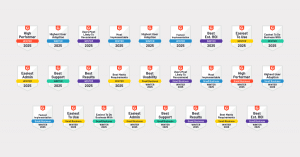Win/loss reports
One update is the win/loss report. What a company wants to be able to track is the sales pipeline. It’s trying to predict revenue in the future. If you know your run rate — ‘normally we bid for this many jobs, and if we bid for that many we win this many jobs’ — you know if you’ve got enough work coming up.
We’ve enabled Synergy to track how many new jobs are in the system. Month-by-month, how many new jobs went on, how many of those moved from the ‘new’ state into the ‘won’ or the ‘lost’ state. So you can now track and graph your run rate.
Based on that you should be able to say, ‘Well, if we’ve got this many things in the queue, then based on history, we’re likely to win this number of projects,’ and you can either track it by number of jobs in the queue or by revenue in the queue.
We’ve added a new dashboard widget for managers, so they can see this at a glance, and some new reports that show it in greater detail.
We know that’s going to be popular. The win/loss dashboard’s making friends everywhere already.
The road to weekly planning
The other major update in the February release represents another milestone on our ‘resourcing journey’. We know, it’s exciting. All these new resourcing vista to enjoy!
Many moons ago, to start a new project in Synergy, you had to fill in a lot of data about it. Information you may not have had if the project was only an opportunity at that point — maybe you’ve heard that next year the government’s thinking about building a hospital, and you don’t even know where it is. You don’t know who the project contact is, you don’t know the address. You don’t know anything about it, but if they do build a hospital, you want to put it in the system as something to chase. Like a place holder.
That’s about as much effort as you want to put into the planning at that point, because it may never happen — change of government, it gets wiped off the books.
We made that easy in the previous release. Like having a wide lens, fully open on the view — everything’s in sight but it’s all pretty blurry. When a project does go into the system at that opportunity stage, Synergy automatically generates enough information — based on some stuff like, when you think it’s going to happen, how long you think it’ll take, and what the fees might be. Synergy starts generating cashflow forecasting information, and resource impact information.
With very little effort you’ve got some help in your capacity planning, to answer the golden question, ‘If I win all this work, will I have enough staff to deliver the work?’ and ‘Is there enough work in my pipeline to keep my staff busy?’
Lookin’ good. Nice view. Impressionistic, but nice.
That was a good first step.
Proceeding along the planning path
We were pleased and proud and you said you loved it. But now, as those projects become closer and more real, it’s worth putting a little bit more effort into them, and making them more realistic. Like the camera slowly zooms in and shows more detail.
As it starts to get a bit closer you can then apply a template. You might have a hospital template, so you’d apply the hospital template and it tells you:
- This is what we generally do when we build a hospital
- Here’s how much effort we spend at various stages of the project
- That’s when we need lots of people
- Then’s when we don’t need so many people
- We make most of our fees here (we might make a loss in our fees there, but we make up money in our fees over here)
You can model all of that into a template and apply that to the project and very quickly get a much more detailed, plausible project plan. Getting closer to something that you could even provide a tender price from. Pulling that view into focus.
They were the first two steps. Getting closer and closer, but then what happens when you win the job?
When the job’s actually running you need more detail than simply having a bunch of staff assigned to it, or to the whole of a certain stage. An example could be, the design director may be involved for the first couple of weeks of the design phase while the design really gets started, then might flit off onto another project, and then when it’s all getting wrapped up at the end, they’ll come back and take the accolades … I mean, they’ll come back and help finish the project. *nudge*
In the previous release, Synergy averaged that director’s time across the entire project. In this release, we’ve gone that step further where you can say, ‘No, actually it’s not a little bit of time across the entire project, she’s full-time for a week in the beginning, full-time for a week at the end’ and you can model that much more clearly.
Again, that’s a stepping stone towards detailed week-by-week resourcing.
The sunny resourcing road ahead
In the next release, for those who like numeric data entry screens, you’ll be able to say, ‘This person is working on this stage of this project for this number of hours next week,’ — being really specific about who’s doing what and for how long.
One of the things we’re planning to build into resourcing is the ability to report based on what people scheduled for the work, and what was actually on the timesheets. Were we even close? I don’t think anybody out there actually measures that at the moment. And as a result, they’re not measuring when they’re improving at it, or what the relationship is between the guess and the actuality, or whether the estimates are improving in accuracy or not. This way you’ll see if you are learning from lessons. This one’s been requested by lots of customers with several project teams, and we’re excited to deliver.
Later in the year we’re getting even more granular. We’ve gone from a project in the future, where you don’t even know what’s going to happen, and now we’ve got it right down to week-by-week, who’s working on what. Ultimately, we plan to use kanban (see Trello as an example of kanban) to get right down to day-to-day task management.
Broad view, with focus. It’s a pretty landscape. Soak it up and smile.



